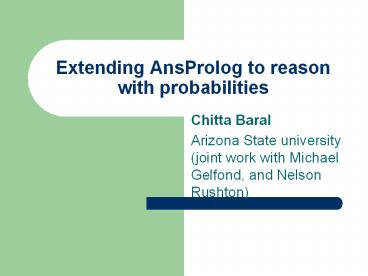Extending AnsProlog to reason with probabilities - PowerPoint PPT Presentation
Title:
Extending AnsProlog to reason with probabilities
Description:
The candidate has three choices of doors. ... The possibility to choose each of the doors 1, 2, or 3 is 1/3 each: Candidate chooses p ... – PowerPoint PPT presentation
Number of Views:54
Avg rating:3.0/5.0
Title: Extending AnsProlog to reason with probabilities
1
Extending AnsProlog to reason with probabilities
- Chitta Baral
- Arizona State university (joint work with Michael
Gelfond, and Nelson Rushton)
2
Motivation The Monty Hall problem
- A player is given the opportunity to select one
of three closed doors, behind one of which there
is a prize, and the other 2 rooms are empty. - Once the player has made a selection, Monty is
obligated to open one of the remaining closed
doors, revealing that it does not contain the
prize. - Monty gives a choice to the player to switch to
the other unopened door if he wants. - Question Does it matter if the player switches,
or - Which unopened door has the higher probability of
containing the prize?
3
Go to White board
- http//www.remote.org/frederik/projects/ziege/bewe
is.html
4
Illustration-1
- First, let us assume that the car is behind door
no. 1. - We can do this without reducing the validity of
our proof, because if the car were behind door
no. 2, we only had to exchange all occurrences of
"door 1" with "door 2" and vice versa, and the
proof would still hold. - The candidate has three choices of doors.
- Because he has no additional information, he
randomly selects one. - The possibility to choose each of the doors 1,
2, or 3 is 1/3 each - Candidate chooses p
- Door 1 1/3
- Door 2 1/3
- Door 3 1/3
- Sum 1
5
Illustration-2
- Going on from this table, we have to split the
case depending on the door opened by the host. - Since we assume that the car is behind door no.
1, the host has a choice if and only if the
candidate selects the first door - because
otherwise there is only one "goat door" left! - We assume that if the host has a choice, he will
randomly select the door to open. - Candidate chooses Host opens p
- Door 1 Door 2 1/6
- Door 1 Door 3 1/6
- Door 2 Door 3 1/3
- Door 3 Door 2 1/3
- Sum 1
6
Illustration-3
- candidate who always sticks to his original
choice no matter what happens - Candidate chooses Host opens final choice win
p - Door 1 Door 2 Door 1
yes 1/6 - Door 1 Door 3 Door 1
yes 1/6 - Door 2 Door 3 Door 2 no
1/3 - Door 3 Door 2 Door 3 no
1/3 - Sum1 Sum of cases where candidate wins 1/3
- candidate who always switches to the other door
whenever he gets the chance - Candidate chooses Host opens final choice win
p - Door 1 Door 2 Door 3 no 1/6
- Door 1 Door 3 Door 2 no 1/6
- Door 2 Door 3 Door 1 yes 1/3
- Door 3 Door 2 Door 1 yes 1/3
- Sum1 Sum of cases where candidate wins
2/3
7
Key Issues
- The existing languages of probability do not
really give us the syntax to express certain
knowledge about the problem - Lot of reasoning is done by the human being
- Our goal Develop a knowledge representation
language and a reasoning system such that once we
express our knowledge in that language the system
can do the desired reasoning - P-log is such an attempt
8
Representing the Monty Hall problem in P-log.
- doors 1, 2, 3.
- open, selected, prize, D doors
- can_open(D) ?selected D.
- can_open(D) ? prize D.
- can_open(D) ?not can_open(D).
- pr(openD c can_open(D), can_open(D1), D / D1
) ½ - By default pr(open D c can_open(D) ) 1 when
there is no D1, such that -
can_open(D1) and D / D1 . - random(prize), random(selected).
- random(open X can_open(X)).
- pr(prize D) 1/3.
- pr(selected D) 1/3.
- obs(selected 1). obs(open 2). obs(prize
2).































